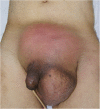Incarcerated sigmoid colon cancer in an inguinal hernia sac associated with an abdominal wall abscess: a case report
- PMID: 31807907
- PMCID: PMC6895366
- DOI: 10.1186/s40792-019-0742-2
Incarcerated sigmoid colon cancer in an inguinal hernia sac associated with an abdominal wall abscess: a case report
Abstract
Background: An inguinal hernia is a common disease; however, a malignant tumor within the inguinal hernia sac is rare, and perforated colon cancer in the hernia sac is extremely rare.
Case presentation: A 73-year-old man presented to our hospital with high fever and painful bulging of the lower abdomen. Computed tomography showed air-containing fluid in the abdominal wall, as well as localized wall thickness of the sigmoid colon in the left groin. An emergency operation revealed a huge subcutaneous abscess and a hard mass of the sigmoid colon within an indirect inguinal hernia sac. Sigmoidectomy and hernia repair using the Marcy method were performed. Lymph node dissection was performed through a transrectal abdominal incision. Histopathological examination of the resected specimen revealed moderately differentiated adenocarcinoma invading the serosal layer with lymph node metastasis.
Conclusions: Incarcerated inguinal hernia with perforated colon cancer is rare; an emergent operation should accordingly be performed based on infection control, oncological principles, and secure hernia repair.
Keywords: Abscess; Colorectal cancer; Inguinal hernia.
Conflict of interest statement
The authors declare that they have no competing interests.
Figures




Similar articles
-
Sigmoid Colon Cancer Masquerading as a Right Incarcerated Inguinal Hernia: A Case Study and Literature Review.Front Surg. 2022 Feb 17;9:832771. doi: 10.3389/fsurg.2022.832771. eCollection 2022. Front Surg. 2022. PMID: 35252338 Free PMC article.
-
Perforated sigmoid colon cancer presenting as an incarcerated inguinal hernia: A case report.Int J Surg Case Rep. 2020;72:108-111. doi: 10.1016/j.ijscr.2020.05.067. Epub 2020 Jun 6. Int J Surg Case Rep. 2020. PMID: 32534412 Free PMC article.
-
Incarcerated right inguinal hernia containing sigmoid colon: An unusual case report.Int J Surg Case Rep. 2022 Jun;95:107237. doi: 10.1016/j.ijscr.2022.107237. Epub 2022 May 21. Int J Surg Case Rep. 2022. PMID: 35636214 Free PMC article.
-
Metachronous metastasis to inguinal lymph nodes from sigmoid colon adenocarcinoma with abdominal wall metastasis: a case report.BMC Cancer. 2019 Feb 27;19(1):180. doi: 10.1186/s12885-019-5386-x. BMC Cancer. 2019. PMID: 30813921 Free PMC article. Review.
-
Elective laparoscopic surgery for sigmoid colon carcinoma incarcerated within an inguinal hernia: report of a case.Surg Today. 2014 Jul;44(7):1375-9. doi: 10.1007/s00595-013-0664-8. Epub 2013 Jul 12. Surg Today. 2014. PMID: 23846798 Review.
Cited by
-
Incomplete bowel obstruction caused by sigmoid colon cancer in an inguinal hernia: a case report.Surg Case Rep. 2024 Apr 24;10(1):99. doi: 10.1186/s40792-024-01874-1. Surg Case Rep. 2024. PMID: 38656705 Free PMC article.
-
Sigmoid Adenocarcinoma Discovered in an Incarcerated Inguinal Hernia.Cureus. 2025 Aug 9;17(8):e89679. doi: 10.7759/cureus.89679. eCollection 2025 Aug. Cureus. 2025. PMID: 40932970 Free PMC article.
-
Incarcerated sigmoid large-cell neuroendocrine carcinoma in an inguinal hernia.J Surg Case Rep. 2021 Feb 8;2021(2):rjaa585. doi: 10.1093/jscr/rjaa585. eCollection 2021 Feb. J Surg Case Rep. 2021. PMID: 33604019 Free PMC article.
-
Sigmoid Colon Cancer Masquerading as a Right Incarcerated Inguinal Hernia: A Case Study and Literature Review.Front Surg. 2022 Feb 17;9:832771. doi: 10.3389/fsurg.2022.832771. eCollection 2022. Front Surg. 2022. PMID: 35252338 Free PMC article.
-
Sigmoid colon cancer presenting as a left inguinal hernia: a case report.Ann Med Surg (Lond). 2023 Sep 5;85(11):5653-5655. doi: 10.1097/MS9.0000000000001238. eCollection 2023 Nov. Ann Med Surg (Lond). 2023. PMID: 37915716 Free PMC article.
References
-
- MacFadyen BV, Jr, Mathis CR. Inguinal herniorrhaphy: complications and recurrences. Semin Laparosc Surg. 1994;1:128–140. - PubMed
Grants and funding
LinkOut - more resources
Full Text Sources

